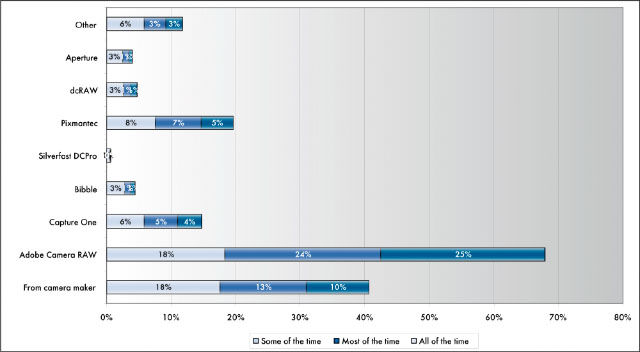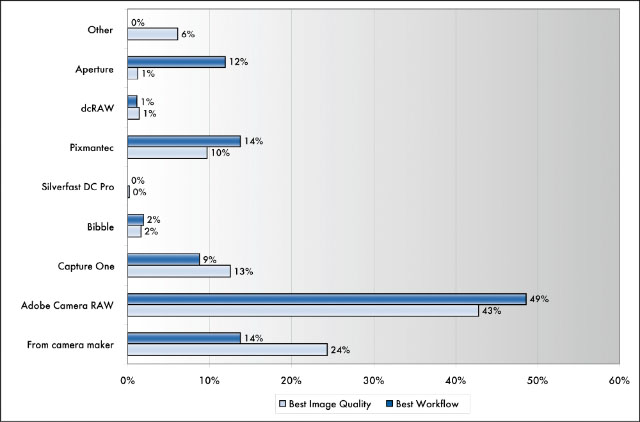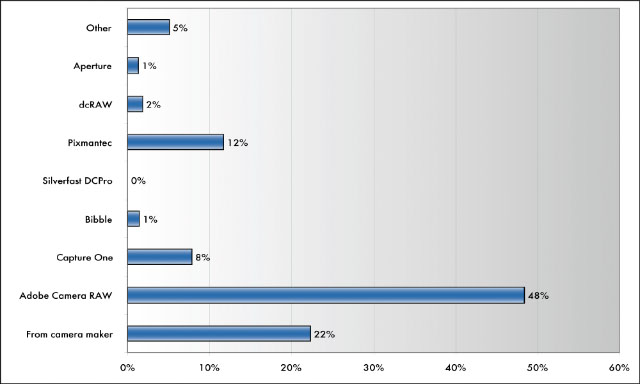The 2006 RAW Survey - Chapter 3
Chapter 3. RAW Image File Conversion and Editing Software
Use of RAW File Conversion and/or Editing Software
Survey Question #6 asked: "How often do you use each of the following RAW image conversion or editing software products?" Eight products were listed in the question, and respondents were also allowed to specify an "Other" product. Chart 14 displays the percentages of respondents who indicated that they used each of the nine products (including "other") "some of the time," "most of the time," or "all of the time." The response categories "rarely" and "never" are not shown in the table. In fact, over 80% of respondents reported they had "never" or "rarely" used seven of the nine products (including "other") listed in the question.
Chart 14. Percentage of Respondents that Use Listed RAW Conversion/Editing Software Packages
For four of the listed products (Bibble, Silverfast, dcRAW, and the newly-released Aperture), very few respondents (5% or less) used them at least "some of the time." Less than 2% of respondents used any of these four products either "all" or "most of the time." Overall, about 15% of respondents reported using any form of Phase One’s Capture One products, with under 10% indicating they used it "all" or "most of the time." RAW Shooter products from Pixmantec were used by nearly 20% of respondents, with about 12% indicating they used it "all" or "most of the time." "Other" products were named by only 12% of respondents, with only half of these (6%) indicating they used the "other" product "most" or "all of the time."
Only two of the listed products – software produced by the respondents’ camera makers and Adobe’s Camera RAW were used at least "some of the time" by substantial numbers of respondents. Just over 40% indicated that they used software from their camera makers, with just under one-quarter (23%) reporting they used these products "most of the time" (13%) or "all of the time" (10%). Two-thirds of respondents (67%) reported using Adobe Camera RAW, with nearly half of respondents indicating they used ACR "most of the time" (24%) or "all of the time" (25%).
Respondents were also asked two questions to determine which of the listed software products they believe [1] "delivers the best image quality," and [2] "provides the best workflow" for their photography. Chart 15 shows the response distributions for these two questions.
The percentages in Chart 15 should not be interpreted as if all respondents are necessarily making experience-based comparisons among all the listed products. For example, some respondents may have no experience with some of the software products, while others may have decided against using certain products based on careful evaluation and comparisons among them. Despite these limitations on interpretation, about 95% of respondents believed they had sufficient information about the listed products to indicate which one they believed was best for each of the two purposes.
Moreover, we believe this limitation on the interpretation of the response patterns is not a significant disadvantage. Very few photographers or imaging specialists will have the interest or the resources to carry out extensive direct comparisons of all software products under ideal conditions. This fact does not prevent them from forming perceptions and/or making choices among software products based on other information, such as product reviews or the opinions and/or recommendations of colleagues, teachers, and other trusted resources. That said, the results presented here should be interpreted in the context of both the limitations of the survey design and the limitations, as described above, in respondents’ exposure to the listed software products.
Chart 15. Percentage That Believe Each of the Listed Software Products Provides
Them with "The Best Image Quality," and "The Best Workflow"
With respect to image quality, most respondents (43%) indicated that Adobe Camera RAW provided the "best image quality" for their photography. This percentage is significantly higher than for all other software products, including software from respondents’ camera makers (24%), and independent developers such as Phase One’s Capture One (13%), Pixmantec products (10%), and "Other" named products (6%). Less than 3% of respondents indicated that Bibble, Silverfast DCPro, dcRAW, or Aperture provided the "best image quality." We cannot determine whether the ratings for these four products results from low market penetration, or because they have been evaluated by respondents and rejected for regular use.
Most respondents (49%) also reported that Adobe Camera RAW provided them with the "best workflow" for handling RAW images. This percentage is also far higher than for any other listed software product, including software from camera makers (14%), Pixmantec (14%), Aperture (12%), and Capture One (9%). Similar to the image quality ratings, less than 3% of respondents mentioned either Bibble, Silverfast, dcRAW, or their own named "other" product as providing the "best workflow."
The percentages shown in Chart 15 reveal that respondents have somewhat different views of the strengths of the software products that they’ve used. For example, if we compare the percentages of respondents who name each product for the "best image quality" and the "best workflow," we see that larger percentages of respondents indicate that Adobe Camera RAW, Pixmantec products, and Aperture provide the "best workflow" than say these products deliver the "best image quality." Conversely, respondents are more likely to report that software from camera makers and Capture One provides the "best image quality," than they are to indicate that those products provide the "best workflow." (This also appears to be true of respondents who named "other" software products.)
The differences in percentages of respondents that report a given software product provides the "best image quality" versus "best workflow" is, to a significant degree, an indication that respondents believe they must make tradeoffs to achieve their personal goals (or those of their clients). As we will see in additional analyses presented below, the desire for software that combines "best image quality" and "best workflow" is a source of frustration that we believe is reflected in the opinions expressed in response to other questionnaire items.
Chart 16 displays the percentage of respondents that indicated that they used each of the nine software products "most often" for converting or editing their RAW image files. The pattern is similar to that shown in Chart 14, although that chart reflects that most respondents reported using more than one software product.
Chart 16. Percentage That Report Using Each Listed Software Product "Most Often"
Nearly half of all respondents (48%) reported that Adobe Camera RAW was the software product they used most often. Software from respondents’ camera makers were the next most commonly mentioned as the product used "most often" (22%) – but less than half the percentage that named ACR as their "most often" used software. About 12% of respondents named Pixmantec products, followed by 8% who specified Capture One, and 5% who named an "other" product.
Among 2006 RAW Survey respondents, Adobe Camera RAW was clearly the product most commonly chosen for conversion and/or editing of RAW image files. However, ACR was mentioned as the product used "most often" by less than half of the respondents. This suggests that there is no software solution that dominates the perceptions of RAW image users for both "best image quality" and "best workflow." Many photographers and imaging specialists are interested in a better solution than the market now offers them.
Table 6 displays the percentage of respondents that identified each software package as the one they used "most often" separately for the six categories of photography users. Although the patterns are roughly similar to those observed for all respondents, some differences are apparent. Professional photographers and graphic arts specialists are significantly more likely than others to indicate that they use Adobe Camera RAW most often, ranging from 54% to 61% (compared to 48% for all respondents). Respondents who identified themselves as "hobbyists" were considerably less likely than other groups (35%) to report that they used Adobe Camera RAW "most often." On the whole, there are relatively few percentages in Table 6 that represent large differences (greater than 5 percentage points) in software use patterns between any particular category of photography user and the overall distribution shown in Chart 16.
Table 6. Software Product Used "Most Often" to Convert/Edit RAW Image Files by Categories of Photography Users
| Full time professional | Part time professional | Graphic arts professional - not photographer | Technical use for non-photography profession | Dedicated amateur | Hobbyist | |
|---|---|---|---|---|---|---|
| From camera maker | 21% | 20% | 18% | 24% | 22% | 28% |
| Adobe Camera RAW | 58% | 54% | 61% | 43% | 45% | 35% |
| Capture One | 12% | 9% | 7% | 4% | 7% | 6% |
| Bibble | 1% | 2% | 1% | 2% | 2% | 1% |
| Silverfast DC Pro | 0% | 0% | 0% | 0% | 0% | 0% |
| Pixmantec | 4% | 9% | 5% | 11% | 15% | 16% |
| dcRAW | 0% | 0% | 1% | 4% | 2% | 5% |
| Aperture | 1% | 1% | 3% | 1% | 1% | 1% |
| Other | 3% | 4% | 5% | 9% | 6% | 8% |
| Total | 100% | 100% | 100% | 100% | 100% | 100% |
However, while there is nearly a three-to-one preference for Adobe Camera RAW over camera makers’ software among professional photographers and graphic arts pros, that ratio is closer to two-to-one for technical photography users, dedicated amateurs, and hobbyists.


